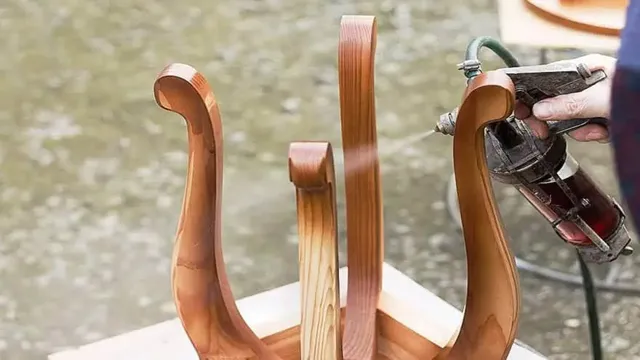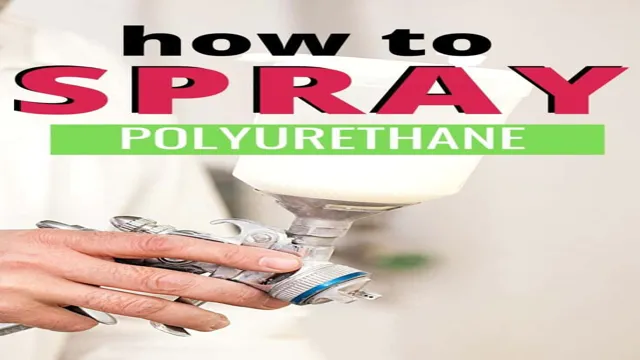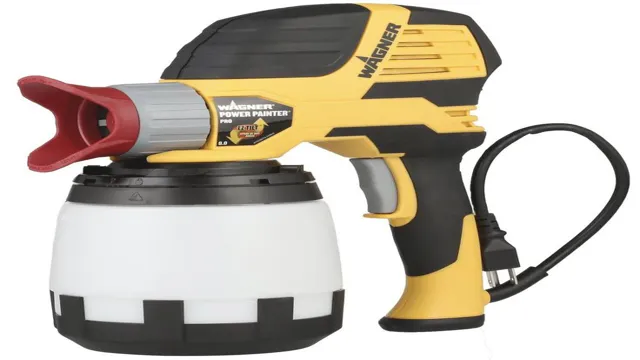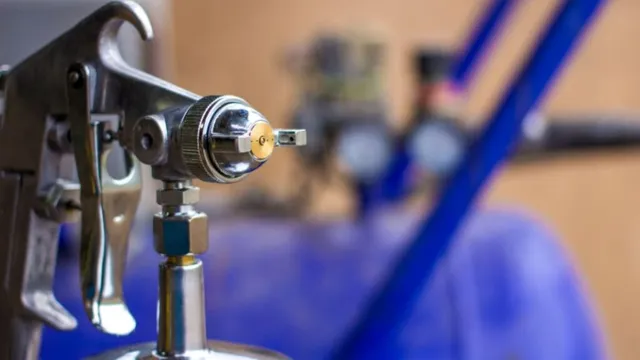Can You Spray Polyurethane Through a Paint Sprayer? Expert Guide and Tips

Are you looking for a quick and efficient way to apply polyurethane to your next DIY project? Look no further than spraying polyurethane through a paint sprayer! Using a paint sprayer is an easy and effective method for achieving a smooth, even coat of polyurethane on wood, metal, and other surfaces. Plus, it’s faster than traditional methods like brushing or rolling, saving you time and effort. In this blog post, we’ll cover everything you need to know about spraying polyurethane through a paint sprayer, from choosing the right equipment to tips for achieving a flawless finish.
Let’s get started!
Introduction
If you’re wondering whether you can spray polyurethane through a paint sprayer, the answer is yes, but it’s not as straightforward as you might think. Polyurethane is a thick and viscous liquid that requires a high volume, low-pressure (HVLP) sprayer, which is specifically designed for thick materials. Most ordinary paint sprayers won’t work effectively with polyurethane, as the material will either clog up the nozzle or produce an uneven and blotchy finish.
Additionally, you’ll need to thin down the polyurethane to the right consistency, which requires the use of a solvent or thinner. It’s essential to follow the manufacturer’s instructions and wear proper safety gear, as solvents can be hazardous to your health. In summary, while you can spray polyurethane through a paint sprayer, it’s crucial to ensure you have the right equipment and follow proper procedures to achieve a smooth and professional finish.
What is Polyurethane?
Polyurethane is a versatile material that is used in a variety of industries and applications. It is a polymer that is made up of urethane units, and it can be formed into foams, adhesives, coatings, and elastomers. One of the advantages of polyurethane is its flexibility – it can be adjusted to have different properties depending on the application.
For example, polyurethane foam can be soft and springy for use in mattresses, or it can be rigid and durable for use in building insulation. This adaptability makes polyurethane a desirable material for manufacturers who need to create products with specific performance characteristics. Whether it’s used in car parts, furniture, or high-end athletic shoes, polyurethane is an important material that has a major impact on our daily lives.

Benefits of Using a Paint Sprayer for Polyurethane
When it comes to applying polyurethane, one of the best tools you can use is a paint sprayer. Not only does it save time compared to traditional brush or roller methods, but it also provides a smoother and more consistent finish. By using a paint sprayer, you can easily cover large surfaces, corners, and hard-to-reach areas with minimal effort.
Plus, the sprayer evenly distributes the polyurethane, eliminating the risk of brush marks or uneven coats. Overall, using a paint sprayer for polyurethane is a game-changer, especially for those looking to achieve a professional-looking finish.
How to Spray Polyurethane Through a Paint Sprayer
Yes, you can spray polyurethane through a paint sprayer, but it is important to follow some specific steps to ensure that the process is successful. First and foremost, make sure to choose the right paint sprayer for the job. Look for a sprayer with a tip size of at least 0.
015 inches and a high enough pressure to properly atomize the polyurethane. Additionally, it is important to properly thin the polyurethane before spraying. A 1:1 ratio of polyurethane to mineral spirits or paint thinner is a good starting point, but be sure to check the manufacturer’s guidelines for specific instructions.
Finally, make sure to strain the polyurethane before pouring it into the sprayer and clean the sprayer thoroughly after each use to prevent clogs and buildup. By following these steps, you can achieve a smooth and even coat of polyurethane with your paint sprayer.
Preparing Your Paint Sprayer
Spraying polyurethane through a paint sprayer can seem daunting, but it can be done with the right preparation. Before beginning, it’s important to choose the right tip size for your sprayer, as polyurethane can be thicker than other paints. A larger tip size will ensure a smoother and more even finish.
Next, it’s crucial to clean your sprayer thoroughly, as any leftover paint or debris can clog the nozzle and cause an uneven spray pattern. Once your sprayer is clean, it’s time to mix your polyurethane. Be sure to follow the manufacturer’s instructions and use the appropriate ratio of polyurethane to thinner.
It’s important to strain your mixture before pouring it into your sprayer to prevent any lumps or clumps from getting stuck in the nozzle. With your sprayer loaded and ready to go, be sure to test it on a piece of scrap wood or cardboard before beginning your project. This will give you a sense of how the sprayer works with polyurethane and allow you to make any necessary adjustments to your technique.
With these tips in mind, you can successfully spray polyurethane through a paint sprayer and achieve a smooth, professional-looking finish.
Preparing Your Polyurethane
When it comes to applying polyurethane using a paint sprayer, the first step is to prepare your polyurethane properly. Make sure to check the label instructions of your polyurethane to determine whether it needs to be thinned or not. Most polyurethanes require thinning, and typically, you will need to mix in some mineral spirits to thin the solution to the right consistency.
Too thick, and the polyurethane won’t flow properly through the spray gun, while too thin will result in drips and pooling. Before you start, be sure to strain your polyurethane to remove any impurities that might clog up your spray gun. Once you have properly prepared your polyurethane, it’s time to load it into your paint sprayer and get ready to apply the coating.
Remember to always follow safety guidelines and wear protective gear to prevent any accidents or injury. With the right preparation and technique, spraying polyurethane with a paint sprayer can be an easy and efficient way to achieve a professional finish on your projects.
Spraying Your Polyurethane
Spraying polyurethane can be a tricky task, but with proper preparation and technique, you can achieve professional-level results. To start, make sure your paint sprayer is in good working condition and that you have the correct nozzle and pressure settings for your polyurethane. Before you begin spraying, clean your work surface thoroughly and cover any surrounding areas to prevent overspray.
It’s also important to wear proper personal protective equipment, such as a respirator and goggles. When it comes to spraying, it’s best to keep the nozzle about 6-8 inches away from your work surface and spray in even, sweeping motions. Be sure to overlap your spray passes to prevent any gaps or streaks.
After you’ve finished spraying, allow plenty of time for the polyurethane to cure before handling or applying additional coats. By following these tips, you can achieve a smooth, even finish that will last for years to come.
Safety Precautions
Yes, you can spray polyurethane through a paint sprayer, but it is crucial to ensure certain safety precautions. First, make sure you are using a respirator mask and protective eyewear to avoid inhaling the polyurethane fumes and getting them in your eyes. Also, choose a well-ventilated area to work in, as the fumes can be harmful and even flammable in certain cases.
Moreover, it is important to use the appropriate nozzle size and pressure on your paint sprayer to achieve even coverage and avoid over-spraying. Lastly, pay attention to the drying time of the polyurethane and avoid applying additional coats before the previous one has dried completely. These simple safety measure can ensure that you have a successful and hazard-free application of polyurethane through your paint sprayer.
Protective Gear
When it comes to any physical activity, safety should always be the top priority. This is why it is crucial to wear protective gear to prevent any possible injuries. Protective gear includes helmets, knee pads, elbow wraps, gloves, and other equipment that can protect sensitive areas of the body from impact.
If you’re wondering whether these gears are necessary, then the answer is yes. Wearing them can help you avoid dangerous accidents, especially when you are involved in contact sports or outdoor activities that pose a high risk of injury. Not only can protective gear keep you safe, but it can also give you peace of mind and confidence when performing your activities.
Remember, it only takes one accident to cause a severe injury that can affect your quality of life. Therefore, always prioritize safety and wear protective gear for your own good.
Ventilation
When it comes to safety in ventilation, there are several precautions that need to be taken to ensure the health and safety of individuals. Firstly, it is important to make sure that the ventilation system is regularly maintained and cleaned to reduce the risk of dust and other pollutants spreading throughout the space. Additionally, it is crucial to install carbon monoxide detectors near any combustion sources to detect any potential leaks.
It is also important to ensure that there are no blockages in the ventilation system, which may reduce its efficiency and lead to a buildup of harmful air pollutants. Finally, it is vital to ensure that the ventilation system meets the recommended air exchange rate for the space to prevent the buildup of harmful substances. By implementing these precautions, individuals can ensure that the ventilation system is functioning effectively and protecting their health and well-being.
Conclusion
In conclusion, while technically you can spray polyurethane through a paint sprayer, just because you can doesn’t necessarily mean you should. Not all paint sprayers are created equal, and the viscosity and consistency of polyurethane can pose a challenge for some models. Ultimately, it’s best to consult the manufacturer’s guidelines and exercise caution before attempting to spray polyurethane with a paint sprayer – because as with most things in life, it’s better to be safe than sorry! “
FAQs
What is polyurethane?
Polyurethane is a type of plastic that is commonly used in furniture, bedding, automotive parts, and building materials.
Can polyurethane be sprayed through a paint sprayer?
Yes, polyurethane can be sprayed through a paint sprayer. However, it is recommended to use an airless sprayer or an HVLP (high-volume, low-pressure) sprayer for the best results.
Is it safe to spray polyurethane?
Yes, spraying polyurethane is safe as long as you follow the manufacturer’s instructions and wear appropriate personal protective gear such as gloves, a respirator, and protective eyewear.
How do I prepare my paint sprayer for spraying polyurethane?
Before spraying polyurethane, make sure to clean your paint sprayer thoroughly and choose the right spray tip for the thickness of the polyurethane. It is also important to thin the polyurethane with the appropriate solvent if necessary.
What is the drying time for sprayed polyurethane?
The drying time for sprayed polyurethane depends on a variety of factors such as the temperature, humidity, and thickness of the coat. Generally, it takes about 24 hours for polyurethane to fully cure.
How do I clean up my paint sprayer after spraying polyurethane?
To clean your paint sprayer after spraying polyurethane, use the appropriate solvent recommended by the manufacturer and follow their instructions for cleaning and storage.
Can polyurethane be used on outdoor surfaces?
Yes, polyurethane can be used on outdoor surfaces. However, it is important to choose the appropriate type of polyurethane for your project and make sure to apply it in the right conditions for optimal performance and durability.



